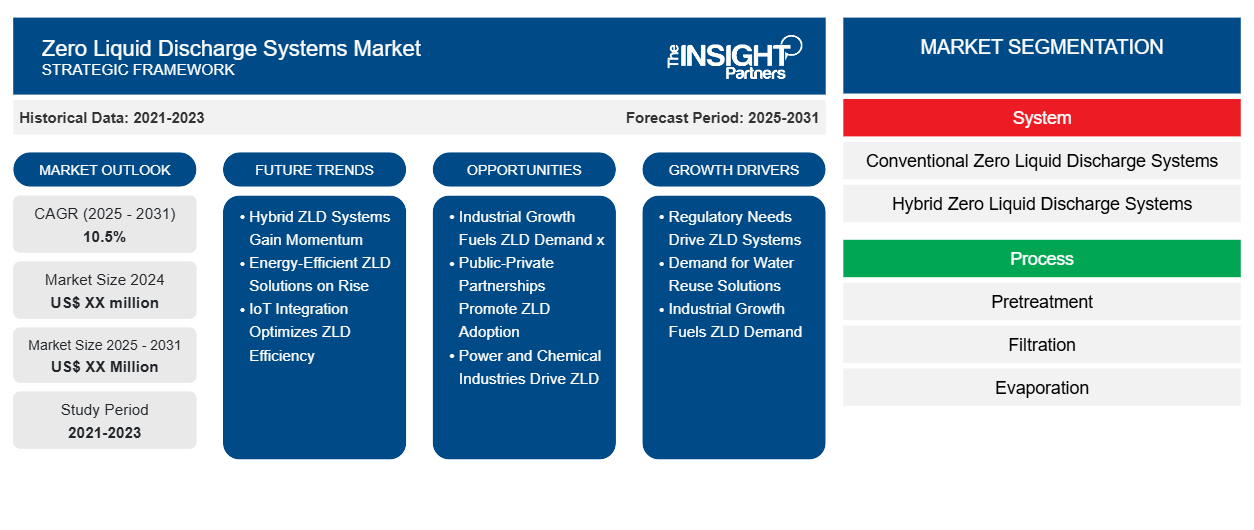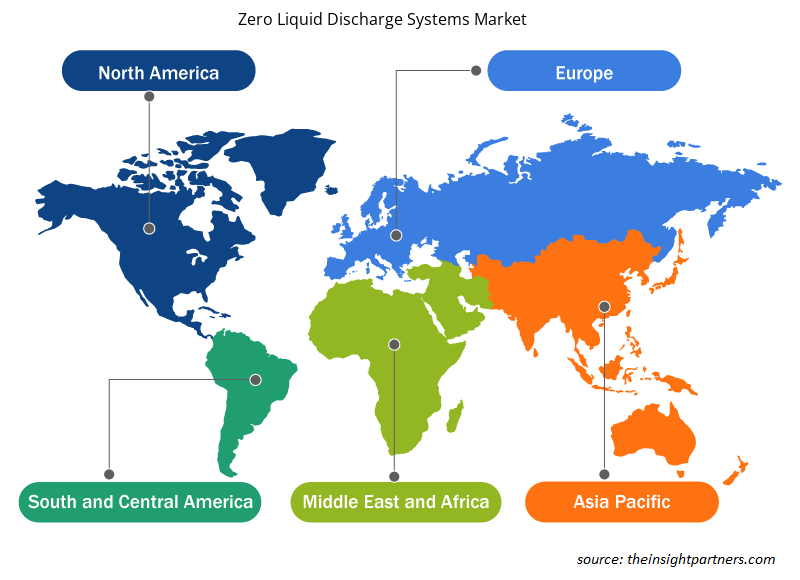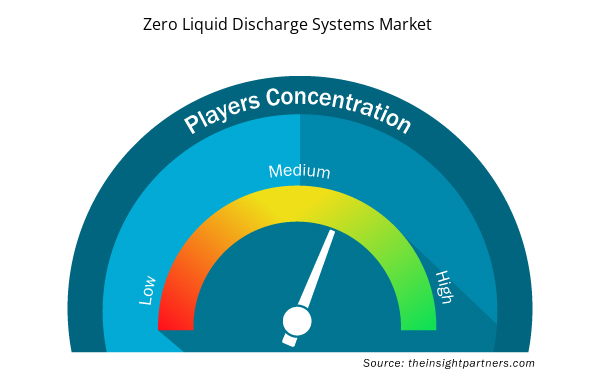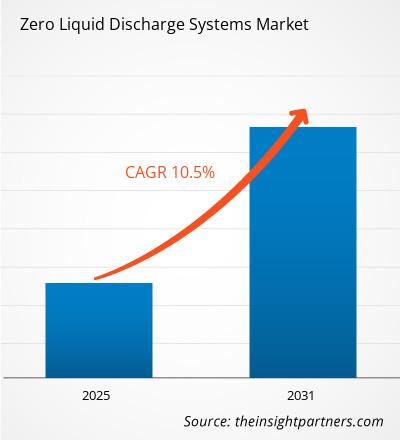The Zero Liquid Discharge Systems Market is expected to register a CAGR of 10.5% from 2025 to 2031, with a market size expanding from US$ XX million in 2024 to US$ XX Million by 2031.
The market is segmented into by System, Process, and End Use Industry. The System segment is divided into Conventional Zero Liquid Discharge Systems, Hybrid Zero Liquid Discharge Systems. Based on Process, the market is segmented into Pretreatment, Filtration, Evaporation, Crystallization. Based on End-Use Industry, the market is segmented into Energy and Power, Chemicals and Petrochemicals, Food and Beverages, Textiles, Pharmaceuticals, Semiconductors and Electronics, Others.
Purpose of the Report
The report Zero Liquid Discharge Systems Market by The Insight Partners aims to describe the present landscape and future growth, top driving factors, challenges, and opportunities. This will provide insights to various business stakeholders, such as:
- Technology Providers/Manufacturers: To understand the evolving market dynamics and know the potential growth opportunities, enabling them to make informed strategic decisions.
- Investors: To conduct a comprehensive trend analysis regarding the market growth rate, market financial projections, and opportunities that exist across the value chain.
- Regulatory bodies: To regulate policies and police activities in the market with the aim of minimizing abuse, preserving investor trust and confidence, and upholding the integrity and stability of the market.
Zero Liquid Discharge Systems Market Segmentation
System
- Conventional Zero Liquid Discharge Systems
- Hybrid Zero Liquid Discharge Systems
Process
- Pretreatment
- Filtration
- Evaporation
- Crystallization
End-Use Industry
- Energy and Power
- Chemicals and Petrochemicals
- Food and Beverages
- Textiles
- Pharmaceuticals
- Semiconductors and Electronics
- Others
Geography
- North America
- Europe
- Asia-Pacific
- South and Central America
- Middle East and Africa
You will get customization on any report - free of charge - including parts of this report, or country-level analysis, Excel Data pack, as well as avail great offers and discounts for start-ups & universities
Zero Liquid Discharge Systems Market: Strategic Insights

- Get Top Key Market Trends of this report.This FREE sample will include data analysis, ranging from market trends to estimates and forecasts.
Zero Liquid Discharge Systems Market Growth Drivers
- Regulatory Pressure for Environmental Compliance: Increasing regulations aimed at reducing industrial waste and promoting sustainable practices are driving the adoption of zero liquid discharge (ZLD) systems. Governments and environmental agencies are enforcing stricter guidelines on wastewater management, compelling industries to implement ZLD solutions to minimize their environmental footprint.
- Water Scarcity and Resource Management: The growing concern over water scarcity is a significant driver for the ZLD market. As industries seek to optimize water usage and reduce dependency on freshwater sources, ZLD systems provide an effective solution by recycling and reusing water, thus enhancing overall water resource management
Zero Liquid Discharge Systems Market Future Trends
- Integration of Smart Technologies: The trend towards automation and smart technologies is influencing the ZLD market. The incorporation of IoT and data analytics into ZLD systems allows for real-time monitoring and optimization of water treatment processes. This trend enhances operational efficiency and helps industries achieve better compliance with environmental regulations.
- Focus on Circular Economy Practices: There is a growing emphasis on circular economy principles within industries, which promotes the reuse and recycling of resources. ZLD systems align well with this trend by enabling the recovery of valuable materials from wastewater and reducing waste generation. This shift towards sustainability is driving interest in ZLD solutions across various sectors
Zero Liquid Discharge Systems Market Opportunities
- Technological Advancements: There is a substantial opportunity for innovation in ZLD technologies. Developing more efficient and cost-effective ZLD systems can attract a broader range of industries, including those that have been hesitant to adopt such technologies due to initial investment costs. Innovations in membrane technology, crystallization processes, and energy recovery systems can enhance the appeal of ZLD solutions.
- Expansion in Emerging Markets: Emerging economies are increasingly recognizing the importance of sustainable water management practices. This presents a significant opportunity for ZLD system providers to enter these markets, where industrial growth is accompanied by rising environmental concerns. Tailoring solutions to meet the specific needs of these regions can lead to substantial market growth
Zero Liquid Discharge Systems Market Regional Insights
The regional trends and factors influencing the Zero Liquid Discharge Systems Market throughout the forecast period have been thoroughly explained by the analysts at Insight Partners. This section also discusses Zero Liquid Discharge Systems Market segments and geography across North America, Europe, Asia Pacific, Middle East and Africa, and South and Central America.

- Get the Regional Specific Data for Zero Liquid Discharge Systems Market
Zero Liquid Discharge Systems Market Report Scope
| Report Attribute | Details |
|---|---|
| Market size in 2024 | US$ XX million |
| Market Size by 2031 | US$ XX Million |
| Global CAGR (2025 - 2031) | 10.5% |
| Historical Data | 2021-2023 |
| Forecast period | 2025-2031 |
| Segments Covered |
By System
|
| Regions and Countries Covered | North America
|
| Market leaders and key company profiles |
Zero Liquid Discharge Systems Market Players Density: Understanding Its Impact on Business Dynamics
The Zero Liquid Discharge Systems Market is growing rapidly, driven by increasing end-user demand due to factors such as evolving consumer preferences, technological advancements, and greater awareness of the product's benefits. As demand rises, businesses are expanding their offerings, innovating to meet consumer needs, and capitalizing on emerging trends, which further fuels market growth.
Market players density refers to the distribution of firms or companies operating within a particular market or industry. It indicates how many competitors (market players) are present in a given market space relative to its size or total market value.
Major Companies operating in the Zero Liquid Discharge Systems Market are:
- Aquarion AG
- Aquatech International LLC
- GE Water and Process Technologies
- GEA Group AG
- H2o GmbH
Disclaimer: The companies listed above are not ranked in any particular order.

- Get the Zero Liquid Discharge Systems Market top key players overview
Key Selling Points
- Comprehensive Coverage: The report comprehensively covers the analysis of products, services, types, and end users of the Zero Liquid Discharge Systems Market, providing a holistic landscape.
- Expert Analysis: The report is compiled based on the in-depth understanding of industry experts and analysts.
- Up-to-date Information: The report assures business relevance due to its coverage of recent information and data trends.
- Customization Options: This report can be customized to cater to specific client requirements and suit the business strategies aptly.
The research report on the Zero Liquid Discharge Systems Market can, therefore, help spearhead the trail of decoding and understanding the industry scenario and growth prospects. Although there can be a few valid concerns, the overall benefits of this report tend to outweigh the disadvantages.
- Historical Analysis (2 Years), Base Year, Forecast (7 Years) with CAGR
- PEST and SWOT Analysis
- Market Size Value / Volume - Global, Regional, Country
- Industry and Competitive Landscape
- Excel Dataset



Report Coverage
Revenue forecast, Company Analysis, Industry landscape, Growth factors, and Trends

Segment Covered
System, Process, End-Use Industry, and Geography

Regional Scope
North America, Europe, Asia Pacific, Middle East & Africa, South & Central America

Country Scope
US, UK, Canada, Germany, France, Italy, Australia, Russia, China, Japan, South Korea, Saudi Arabia, Brazil, Argentina
Frequently Asked Questions
What is the expected CAGR of the Zero Liquid Discharge Systems Market Size and Forecasts (2021 - 2031), Global and Regional Share, Trends, and Growth Opportunity Analysis Report Coverage:by System (Conventional Zero Liquid Discharge Systems, Hybrid Zero Liquid Discharge Systems); Process (Pretreatment, Filtration, Evaporation, Crystallization); End-Use Industry (Energy and Power, Chemicals and Petrochemicals, Food and Beverages, Textiles, Pharmaceuticals, Semiconductors and Electronics, Others) , and Geography (North America, Europe, Asia Pacific, and South and Central America)?
The Zero Liquid Discharge Systems Market Size and Forecasts (2021 - 2031), Global and Regional Share, Trends, and Growth Opportunity Analysis Report Coverage:by System (Conventional Zero Liquid Discharge Systems, Hybrid Zero Liquid Discharge Systems); Process (Pretreatment, Filtration, Evaporation, Crystallization); End-Use Industry (Energy and Power, Chemicals and Petrochemicals, Food and Beverages, Textiles, Pharmaceuticals, Semiconductors and Electronics, Others) , and Geography (North America, Europe, Asia Pacific, and South and Central America) is estimated to witness a CAGR of 10.5% from 2023 to 2031
What are the options available for the customization of this report?
Some of the customization options available based on the request are an additional 3–5 company profiles and country-specific analysis of 3–5 countries of your choice. Customizations are to be requested/discussed before making final order confirmation, as our team would review the same and check the feasibility.
What are the deliverable formats of the zero liquid discharge system market report?
The report can be delivered in PDF/PPT format; we can also share excel dataset based on the request.
What are the driving factors impacting the zero liquid discharge system market?
The major factors driving the zero liquid discharge systemmarket are: Increasing Water Scarcity and Resource Management
Which are the leading players operating in the zero liquid discharge system market
Aquarion AG, Aquatech International LLC, GEA Group AG, H2o GmbH, Ide Technologies, Petro Sep Corporation, Praj Industries Ltd., U.S. Water Services, Inc., Veolia Water Technologies, Fluence Corporation Limited
Trends and growth analysis reports related to Manufacturing and Construction : READ MORE..
The List of Companies
1.Aquarion AG
2.Aquatech International LLC
3.GE Water and Process Technologies
4.GEA Group AG
5.H2o GmbH
6.Ide Technologies
7.Petro Sep Corporation
8.Praj Industries Ltd.
9.U.S. Water Services, Inc.
10.Veolia Water Technologies

 Get Free Sample For
Get Free Sample For